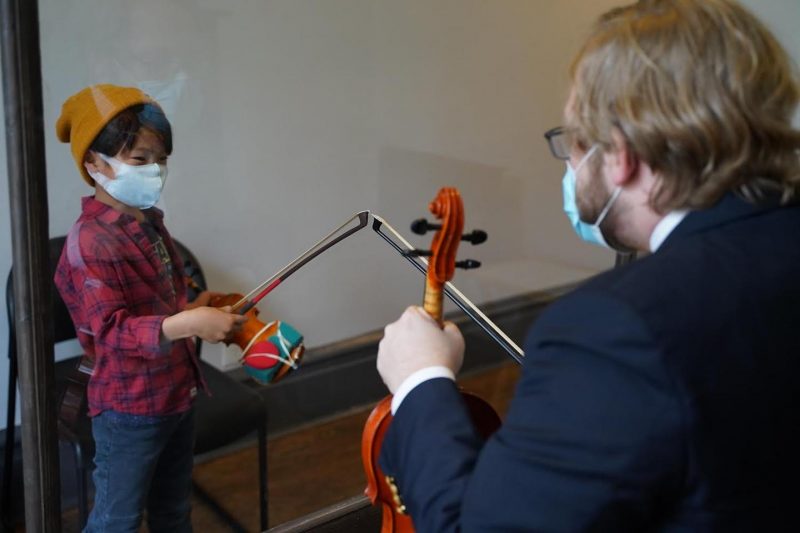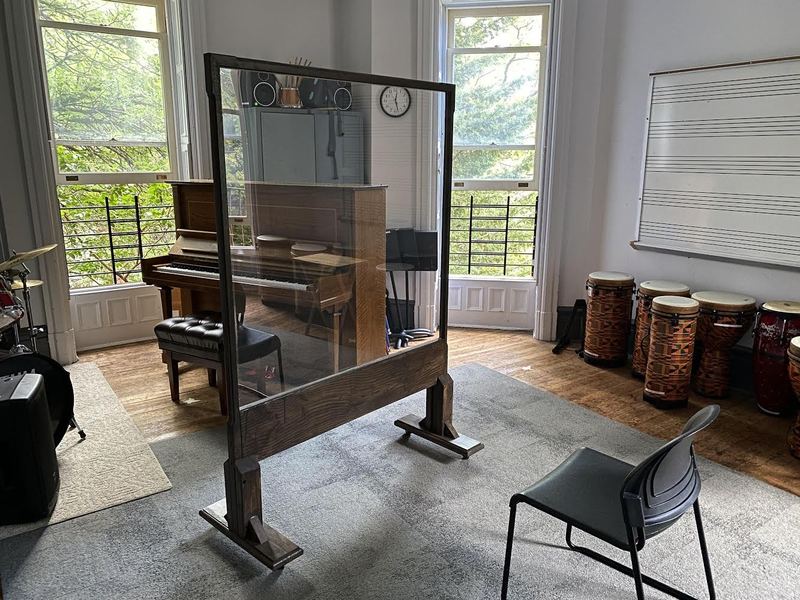K-12 (from kindergarten to 12th grade) Music Education in the Time of COVID-19
Four music education programs talk about moving forward in the midst of the pandemic and its financial fallout.
by Heather O’ Donovan
Over the summer, New York City announced the harrowing news that they were slashing the DOE arts education budget by $15 million, a 70% reduction from the previous $21.5 million budget. The cut has the potential to decimate arts education in the city’s public schools, and to widen the already vast achievement gap between schools in more affluent areas and Title 1 schools in underserved ones.
For luckier, specialized schools like the Celia Cruz Bronx High School of Music and the Special Music School at the Kaufman Music Center, planning for this unprecedented fall semester has boiled down to some common themes, including online vs. hybrid instruction, space constraints, and technological considerations. But for music education programs like the Brooklyn Conservatory of Music and the Harmony Program, planning has hinged on a more urgent question: How can we continue to provide music education to kids whose schools can no longer afford it?
Celia Cruz Bronx High School of Music
At the Celia Cruz Bronx High School of Music — a specialized DOE public high school that boasts six choirs, three string orchestras, two full orchestras, three bands, two jazz bands, and more — music educators were made a core part of the planning process as the school prepared to reopen. This, Celia Cruz’s Music Department Chairperson and Band Director Penelope Smetters-Jacono explains, is a luxury she and her colleagues are grateful for. Music education there is following an opt-in hybrid model this fall, with students and families — as per DOE rules — deciding for themselves whether they’d like to remain entirely remote or come in twice a week for in-person instruction.
The pivot to successful remote music education has been a learning curve: “For any experienced teacher, we know what to do when we’re together. Navigating the remote part is where [teachers] have been putting [their] energy.” The first two weeks of online instruction were devoted to tech support. In her own classes — which have largely been split up into smaller, more manageable sections — she’s been rolling out one piece of tech per week to ensure that the students understand how to use each new program, whether they’re accessing it on a laptop, tablet, or even an Android or iPhone.
“What we’re doing right now is sharpening our swords. You wouldn’t go into battle with a dull sword.” In Zoom classes, students take turns unmuting themselves to lead the class in scales as Smetters-Jacono checks their fingering, embouchure, and, for the leader, pitch accuracy and intonation. “We’re sharpening our individual skills so that when we can come back together, we can concentrate on ensemble things and not worry so much about technical things.
As for the in-person instruction, the priority is on creating meaningful ensemble experiences. The plan allows for small groups of 8 to 10 instrumentalists and vocalists to separately rehearse in large spaces in the building, maintaining 12-foot spacing and wearing masks. For repertoire, Smetters-Jacono has been pulling from the adaptable works of the Creative Repertoire Initiative. Students learn all parts of a given piece on their individual instruments, and then experiment switching the parts around. “They’re exploring timbre and tone color [in a way that] you can’t do in a traditional setting.”
Special Music School — Kaufman Music Center
Like Celia Cruz, the Special Music School, a K–12 partnership between the DOE and the Kaufman Music Center, is uniquely situated. Academic instruction there is provided by the DOE, but funding, implementation, and instruction are all taken care of independently by the Kaufman Music Center. This fall, the majority of instruction will be held remotely, with a handful of opt-in in-person activities scheduled throughout the fall for select ensemble work, along with some outdoor performance opportunities.
Skill-wise, SMS students are remarkably well-prepared for virtual music education. “The kids all took required music technology even before the pandemic,” Kaufman Music Center Executive Director Kate Sheeran explains. The 10th-graders, for example, are fluent in programs like Pro Tools and Ableton, making special recording projects, like this one created last spring with flutist and composer Nathalie Joachim, ever more achievable and meaningful. “When you give kids this education and then they’re in a stressful traumatic time, it’s one of the tools they have to be able to express themselves.”
About 60% of SMS students elected to remain remote for their DOE academic instruction this fall, but the school is beginning to phase in a small amount of in-person music experiences for those students who are comfortable. On Saturday, October 24, for example, a small group of instrumentalists and vocalists, masked and socially distanced, will premiere a new work by Kaufman Music Center Artist-in-Residence Lisa Bielawa at an outdoor performance by the Brooklyn Public Library.
Preparing for on-campus, indoor musical activities has proved somewhat more challenging. The SMS high school, for example, has temporarily relocated from the basement of the Martin Luther King Jr. Educational Complex near Lincoln Center to the Brandeis High School campus on West 84th Street because of ventilation and HVAC concerns. SMS and Kaufman are currently discussing what will happen moving forward.
Because funding for the music program comes from Kaufman rather than the DOE, the school hasn’t experienced any major funding losses this fall. Other public schools haven’t been so lucky.
Brooklyn Conservatory of Music
Schools in underserved areas across NYC rely on DOE funds to bring arts education service providers like the Brooklyn Conservatory of Music (BKCM) into their schools. But with the onset of the pandemic and the subsequent slash in city funding, both urgency for and resources allocated to such “luxuries” disappeared. This fall, BKCM — which, Executive Director Chad Cooper tells me, is beginning to phase in minimal in-person instruction on campus for their Suzuki Program and Community Music School — is working hard to pick up the DOE’s slack.
BKCM’s Music Partners program, which operated in-person in 37 schools pre-pandemic (mostly Title 1), has been working to rebuild its network virtually over the past several months. Director Dorothy Savitch explains: “What happened in the spring was that a lot of children sort of went missing, disappeared. Even the schools could not locate these families. It was a scramble.” Over the spring and summer, BKCM experimented with virtual instruction, working to reach as many students as possible. Innovative programs like the virtual Summer Band Camp brought kids from across the city together. Moving into the fall, Savitch and her team are using the lessons of the past few months as a model to strengthen their virtual offerings, and they’re being aggressive about bringing their work to schools. On the day I spoke with Savitch, she was preparing a presentation for the Learning Bridges Program, a program for the children of essential workers who are participating in hybrid DOE programs: “We want to livestream into these physical classrooms of 8 to 10 students with the use of a smartboard.”
Running parallel to Savitch’s work is that of Toby Williams, Director of BKCM’s Music Therapy program, which partners with schools to provide music therapy services to children with disabilities. This fall, Williams’s team implemented a tele-music therapy model — music therapists Zoom into classrooms of students with disabilities and schedule remote one-on-one sessions for students at home. Williams explains how expectations and priorities have shifted: “What’s important now is that the children have continuity, that they can express themselves and have a body connection at a time when they are forced to sit all day.” They’re prioritizing activities that “use music for self regulation and engagement” and reaching out to families through activity-focused newsletters and videos. Williams is hopeful that in the future, such tele-music therapy will run parallel to in-person therapy to provide more access to children who are not able to come in person.
In their respective programs, Savitch and Williams are doing everything they can to cover the costs associated with their operations. But if you really want to help, Williams and Savitch emphasize, donate.
Harmony Program
The Harmony Program, which, like BKCM, also serves majority Title 1 schools, similarly scrambled at the onset of the pandemic to regroup, locate students, connect with families, assess needs, and get instruments to kids. But, as Founder and Executive Director Anne Fitzgibbon explains, quitting was never an option. “You read about some people pushing pause on their programs, and we were turbocharged.”
Harmony Program’s work this fall will remain fully remote, as it’s been since March, but the richness and variety of the offerings they’re implementing is a testament to the passion Fitzgibbon and her team are bringing to the table. Over the past several months, Harmony Program has built upon and forged partnership programs with such illustrious organizations as the New York Philharmonic, Young Concert Artists, Mostly Mozart Festival, Chamber Music Society, Orpheus Chamber Ensemble, and others. Over Zoom, members of these ensembles coach students and prepare recorded performances, among countless other innovative educational opportunities. Looking toward the future, the Harmony team is excited for what’s to come: “Discovering these technologies that we hadn’t used before has made it possible for us to bring in guest presenters and teachers where it won’t matter where they are [geographically].”
But perhaps the most exciting addition to Harmony Program’s fall menu is the brand new video series they’ve just announced — Harmony at Home, a series of recorded lessons in music fundamentals geared toward kids aged 7 to 10 that will feature such guest artists as Anthony McGill and Joshua Bell, and will be provided on YouTube free of charge. As Fitzgibbon explained the particulars of the plan, my mind immediately went to the decade-old YouTube videos from the early days of Khan Academy that are still viewed by millions of students. Could Harmony Program similarly be on the brink of something so game-changing? “Our whole mission has always been to reach the kids who are hard to reach. The pandemic just reminds us of how important that mission is.”

